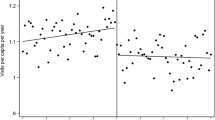Abstract
It is widely recognized that general practitioners (GPs) play a key role in determining the use of resources for ambulatory care. In addition to the GPs' working hours, these resources consist of the work of specialists and that of hospital physicians treating the GPs' referrals and the cost of medication and other measures induced by the GP. Different systems of remuneration differ in their power to lead to efficient service provision. This contribution provides empirical evidence on the efficiency of service provision by Austrian GPs. The analysis is based on data for some 600 GPs. The data comprise sufficient information to assess the GPs' efficiency with regard to the way they manage their cases. Data Envelopment Analysis, a nonparametric technique, is used to estimate the production frontier. The results suggest that almost one-half of the GPs in the sample have a relative efficiency of 0.8 or less. A Malmquist decomposition of the productivity change reveals a decline in productivity. This is due to a pronounced negative shift of the frontier whereas individual efficiency rises against the weaker benchmark of the new frontier.


Similar content being viewed by others
References
Ali AI (1994) Computational aspects of DEA. In: Charnes A, Cooper WW, Lewin A, Seiford LM (eds) Data envelopment analysis: theory, methodology, and application. Kluwer: Boston
Andersen P, Petersen NC (1993) A procedure for ranking efficient units in data envelopment analysis. Manage Sci 39:1261–1264
Burgess JF, Wilson PW (1995) Decomposing hospital productivity changes 1985–1988: a nonparametric Malmquist approach. J Productiv Anal 6:343–363
Cooper WW, Seiford LM, Tone K (2000) Data envelopment analysis: a comprehensive text with models, applications, references and DEA-solver software. Kluwer: Boston
Chilingerian JA, Sherman HD (1997) DEA and primary care physician report cards: deriving preferred practice cones from managed care service concepts and operation strategies. Ann Oper Res 48:35–66
Dulá JH, Hickman BL (1997) Effects of excluding the column being scored from the DEA evelopment LP technology matrix. J Oper Res Soc 73:35–66
Eisenberg JM (1986) Doctors' decisions and the cost of medical care: the reasons for doctors' practice patterns and ways to change them. Health Administration: Ann Arbor
Hadi AS (1992) Identifying multiple outliers in multivariate data. J R Stat Soc B 54:761–771
Hadi AS (1994) A modification for a method for the detection of outliers in multivariate samples. J R Stat Soc B 56:393–396
Hollingsworth B, Dawson PJ, Maniadakis N (1999) Efficiency measurement of health care: a review of non-parametric methods and applications. Health Care Manage Sci 2:161–172
Kittelsen AC (1999) Monte Carlo simulations of DEA efficiency measures and hypothesis tests. Memorandum 09/99. University of Oslo, Department of Economics: Oslo
Kneip A Park B, Simar L (1998) A note on the convergence of nonparametric DEA estimators for production efficiency scores. Econometric Theory 14:783–793
Laffont J-J, Tirole J (1999) A theory of incentives in procurement and regulation. Cambridge
Ley E (1992) Data screening and data envelopment analysis. Economic and Financial Modelling With Mathematica Hal Varian. Springer-Telos: Heidelberg
Ozcan YA (1998) Physician benchmarking: measuring variation in practice behaviour in treatment of otitis media. Health Care Manage Sci 1:5–17
Seiford LM, Zhu J (1999) Infeasibility of super-efficiency data envelopment analysis models. Inforation 37:174–187
Simar L, Wilson PW (2000) Statistical inference in nonparametric frontier models: the state of the art. J Productiv Anal 13:49–78
Scott A (2000) Economics of general practice. In: Anthony JC, Newhouse JP Handbook of health economics. Elsevier: Amsterdam
Wilson PW (1993) Detecting outliers in deterministic nonparametric frontier models with multiple outputs. J Business Econ Stat 11:319–323
Xue M, Harker PT (2002) Note: ranking DMUs with infeasible super-efficiency DEA models. Manage Sci 48:705–711
Author information
Authors and Affiliations
Corresponding author
Rights and permissions
About this article
Cite this article
Staat, M. The efficiency of treatment strategies of general practitioners. HEPAC 4, 232–238 (2003). https://doi.org/10.1007/s10198-003-0199-9
Issue Date:
DOI: https://doi.org/10.1007/s10198-003-0199-9




